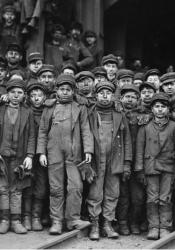Child Labor in London
One of the scenes in Charles Dicken’s “A Christmas Carol” Ebenezer Scrooge is seen giving Bob Cratchit a raise. This can be further explored as a way of Dicken’s literature addressing the social issues that were occurring in the time period the novel was written in, 1843. During this time, London was experiencing an economic depression with harsh child labor conditions that would leave children working for hours on end with horrid working conditions. In Dicken’s own words, “places of sexual license, foul language, cruelty, violent accidents, and alien manners” (Tuttle). To the audience, Dicken’s scene can be suggesting that employers who act in a way similar to Scrooge, should take care of their employees. Of course, this means all year around, but especially during the holidays.
“Children started working at the earliest ages of 8 and 9 in Britain” (British Library). They would have dangerous jobs such as scavengers (crawl beneath machinery), mining, or machinist. The pay was extremely low for the work and danger the children were apart of. A Christmas Carol was originally a pamphlet that was titled ‘An appeal to the People of England on behalf of the Poor Man’s Child”. Dicken’s resonates with this because he himself worked in a factory as a child. Most of his comments centered around employers exploiting children and treating them as disposable resources rather than humans. “Dickens gave a fundraising speech in 1843 where he urged workers and employers to work together towards educational reform. As passionate as his speech was, Dickens soon realized that the best way to reach a great number of people was to write something incredibly important that masqueraded as an emotional Christmas Story” ('A Christmas Carol' Is Actually about Child Labour, Not the Holidays).
This impacted the reading of the novel by giving the audience someone to resent, admire, and sympathize with. Early novel Ebenezer Scrooge can be seen as the employer with a ton of money and no respect for others. His employee Bob Cratchit can be seen as the working class that has to scrounge for funds. This is where child labor would come into play with poorer families. The change of treatment of others by Scrooge shows the potential for someone who is stuck in Scrooge tendencies to change and become a better person as well as boss.
“'A Christmas Carol' Is Actually about Child Labour, Not the Holidays.” GOAT, 12 June 2020, https://goat.com.au/pop-culture/a-christmas-carol-is-actually-about-chil....
British Library, https://www.bl.uk/romantics-and-victorians/articles/child-labour.
History.com Editors. “Child Labor.” History.com, A&E Television Networks, 27 Oct. 2009, https://www.history.com/topics/industrial-revolution/child-labor.
Tuttle, Carolyn. “Child Labor during the British Industrial Revolution.” EHnet, https://eh.net/encyclopedia/child-labor-during-the-british-industrial-re....

